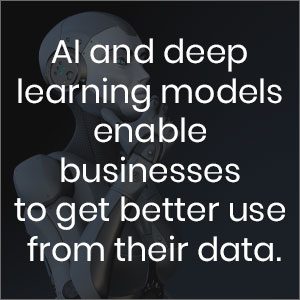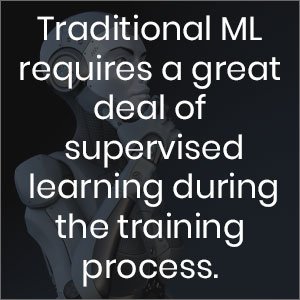These days, there are vast amounts of data in industries, like financial services, legal, retail, healthcare, and manufacturing. More data than several humans could ever wade through in many lifetimes. Fortunately, AI and deep learning models enable businesses to better use their data and make business decisions based on facts, instead of gut instincts.
Of course, the concept of machine learning (ML) is not new. In fact, it has been around for more than half a century. It takes many forms. And, it is how an AI algorithm rationalizes data before committing it to its digital memory. An AI bot or algorithm, in parallel, identifies relationships between data points to make it far easier to find them later. Here is the difference between deep learning vs machine learning.
EFFECTIVE ML REQUIRES EFFICIENT BASIC TRAINING
Generally speaking, AI algorithms are fed a certain amount of training data and given a set of instructions. There needs to be enough data for an AI bot to identify patterns in the information and gain an understanding of how information can be used in the future. This training process is critical. The training data should be expertly selected, and the AI programming needs to be coded and configured with care.
AI and deep learning models enable businesses to get better use of their data. You may view ML simply as data parsing or processing. But it goes well beyond that.
Consider the following definition from AI advisory firm Emerj: “Machine Learning is the science of getting computers to learn and act like humans do, and improve their learning over time in an autonomous fashion, by feeding them data and information in the form of observations and real-world interactions.”
Deep learning is a subset of machine learning, which is a subset of AI. But that only scratches the surface of all the differences between deep learning vs machine learning.
DEEP LEARNING – A NEW FRONTIER FOR ML
Naturally, data takes many forms. Within enterprises and high-growth firms, there are lots of data outside and within corporate firewalls. These include third-party reviews, social media posts, and other online content, which grow at a rapid pace. There is also textual and numeric data, like the information that exists in structured data applications. Then, there are audio files, videos, and images.
To sift through tera, peta, and zettabytes of these kinds of data, various types of bots, algorithms, and machines are needed. And they are dependent on the capabilities of AI platforms like IBM Watson.
DEEP NEURAL NETWORKS AND DEEP LEARNING
In the realm of neural networks, the parallels between human intelligence and AI, and human learning and machine learning are significant.
Neural networks are algorithms that are loosely modeled on the human brain and are purpose-built to recognize patterns in data. Just like a human brain, they work best after they are trained to classify data that has already gone through an initial data parsing. Neural networks enable deep learning, as they are rather good at identifying patterns. But they need a baseline of training or programmed bias inputs. A neural network can then streamline much of the training process and create an acceptable level of bias.
Traditional ML requires a great deal of supervised learning during the training process. However, neural networks make deep learning more autonomous, minimizing the initial programming and testing. In fact, they are capable of unsupervised learning almost from the outset. And they will not allow the AI engine to create too much or too little bias regarding the data that it parses.
Essentially, AI-based platforms consist of many algorithms – in the same way, that human brains have multiple hemispheres, lobes, glands, and other areas. On the Watson AI platform, for instance, different algorithms manage functions, such as:
- Data classification
- Visual or facial recognition (Neural networks often have graphical processing units (GPUs) and central processing units (CPUs) for this advanced type of deep learning)
- Probability scoring (For example, if a contract manager searches for a contract clause within their repository, an algorithm can return a list of recommended clauses weighted by the probability it will suit a given use case. Think about the weighting on a Google search results page)
- Traditional ML requires a great deal of supervised learning during the training process
Neural networks and deep learning also enable users to access information after asking questions in conversational language. In place of a strict keyword or Boolean type searches, chatbots like virtual legal assistants can leverage natural language processing (NLP) to access the content that is needed
So, does your business need to better assemble, review, analyze, and manage contracts throughout their lifecycle? Are you seeking ways to leverage innovative technology like deep learning or machine learning? Is your business on a digital transformation journey? And are you looking for ways to include your legal department in that evolution?
Check out our latest e-book, Three Stages of Legal Digital Transformation, and find out how you can start your own digital transformation journey. That way, you can automate time-intensive, mundane tasks like contract clause review, so that you can spend more time on strategic legal matters.
Author:

Viraj Chaudhary
Connect with us on Linkedin





